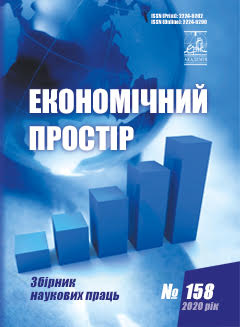THE IMPACT OF A COUNTRY’S ACCESSION TO AN INTEGRATION GROUPING ON ITS COMPETITIVE FORCE
Abstract
The article examines the process of a country's accession to international integration groupings. It emphasizes that upon accession countries rely on either megatrends (globalization, integration and democratization) or "countertrends" (isolationism, disintegration and de-democratization). It is noted that the complex dialectic of megatrends of today's world economy adds to the complexity of the country's positioning in the international arena. The establishment and consistent complication of the transregional architecture of world economic relations has underlined the urgency of a comprehensive understanding of the phenomenon of building up the Member States’ competitive force. The paper considers the forms that countries face during the implementation into the interregional relations system: leadership (international integration grouping that forms the rules and paths of interregional relations); emulation ("import" of a model of another regional group in the process of interaction); cooperation (providing any aid or assistance in the interregional cooperation); exchange (liberalization of trade and economic cooperation). The article identifies the factors determining the "multiplexity of the world economy". A number of indicators for assessing the effectiveness of the county’s accession to the interstate integration grouping on its global competitive force has been determined. The effects of international economic integration that affect the global competitive force of a potential Member State of an international integration grouping have been highlighted: the establishment of a single market, reduction of trade-related costs, redistribution of trade flows, changing the volume and structure of international trade (within the grouping and with third countries); redistribution of investment flows and enhancing international investment; strengthening the international division of labor, structural and technological changes in the manufacturing sector; the price level change and transforming pricing mechanisms, change in the volume and structure of consumption, establishment of a new competitive environment, liberalization of entry into industry markets; changes in employment and wages, education and health systems; implementation of the agreed economic policy, changing the model and quality of state regulation and political strategy of the country.
References
Borzel, T. & Risse, T. (2016). The Oxford Handbook of Comparative Regionalism. Oxford University Press, 1 edition, 560 p.
Gardini G.L., Malamud A. Leadership, Emulation, Cooperation, Exchange. Debunking Interregionalism: Concepts, TypesandCritique – With a Pan-Atlantiс Focus. In: Mattheis F. & Litsegеrd А. (ed) Interregionalism across the Atlantic Space. United Nations University Serieson Regionalism. SpringerIntern.Publ., 2018, 176 p.
Воскресенский А.Д., Колдунова Е.В., Киреева А.А. Трансрегиональные и региональные проекты в условиях «постзападной» международной реальности. Сравнительная политика. 2017. № 2. С. 37–57.
Acharya A. (2017). After Liberal Hegemony: The Advent of a Multiplex World Order. Ethics & International Affairs, September. URL : https://www.ethicsandinternationalaffairs.org/2017/multiplex-world-order/ (дата звернення: 10.09.2020).
Gregory M. (2019). Will national security concern send the globalisation of technology? East Asia Forum, 7 March. URL : https://www.eastasiaforum.org/2019/03/07/will-national-security-concerns-end-the-globalisation-of-technology/ (дата звернення: 09.09.2020).
Piermartini R. & Teh R. (2009). Demystifying Modeling Methods for Trade Policy / Roberta Piermartini, Robert Teh. Geneva : World Trade Organization, WTO Discussion Paper № 10. URL : https://www.researchgate.net/publication/255603044_Demystifying_Modeling_Methods_for_Trade_Policy (дата звернення: 02.09.2020).
Dur A., Baccini L., Elsig M. The Design of International Trade Agreements: Introducing a New Database. Review of International Organizations. 2014. Vol. 9. № 3. Р. 353–375.
Borzel T. & Risse T. (2016) The Oxford Handbook of Comparative Regionalism. Oxford University Press, 1 edition, 560 p.
Leadership, Emulation, Cooperation, Exchange / Gardini G. & Malamud A. Debunking Interregionalism: Concepts, TypesandCritique – With a Pan-Atlantiс Focus. In: Mattheis F. & Litsegеrd А. (ed) Interregionalism across the Atlantic Space. United Nations University Serieson Regionalism. SpringerIntern.Publ., 2018, 176 p.
Voskresenskiy, A., Koldunova, E. & Kireeva, A. (2017). Transregionalnyie i regionalnyie proektyi v usloviyah «postzapadnoy» mezhdunarodnoy realnosti // Sravnitelnaya politika, No 2, Р. 37-57.
Acharya, A. (2017). After Liberal Hegemony: The Advent of a Multiplex World Order. Ethics & International Affairs, September. Retrieved from https://www.ethicsandinternationalaffairs.org/2017/multiplex-world-order/ (дата звернення: 10.09.2020).
Gregory, M. (2019). Will national security concern send the globalisation of technology? East Asia Forum, 7 March. Retrieved from https://www.eastasiaforum.org/2019/03/07/will-national-security-concerns-end-the-globalisation-of-technology/ (дата звернення: 09.09.2020).
Piermartini, R. & Teh, R. (2009). Demystifying Modeling Methods for Trade Policy / Roberta Piermartini, Robert Teh. – Geneva: World Trade Organization, WTO Discussion Paper No 10. Retrieved from https://www.researchgate.net/publication/255603044_Demystifying_Modeling_Methods_for_Trade_Policy (дата звернення: 02.09.2020).
Dur, A. (2014). The Design of International Trade Agreements: Introducing a New Database / A. Dur, L. Baccini, M. Elsig // Review of International Organizations,Vol. 9, No 3, Р. 353–375.



